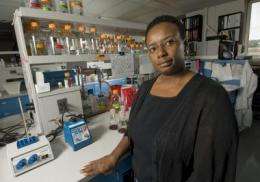Stunting plants' skyward reach could lead to improved yields

In the forest's fight for survival, it's the tallest trees that prevail by reaching for sunlight and shading competition. Corn and other plants, too, divert precious energy to grow higher when nearby plants start to encroach.
Michigan State University plant scientist Beronda Montgomery seeks the key to unlock the processes by which stem growth is stimulated at the expense of seed, flower and leaf production. An assistant professor of biochemistry and molecular biology with the Plant Research Laboratory at MSU, Montgomery in July landed a four-year, $765,249 National Science Foundation grant funded under the American Recovery and Reinvestment Act of 2009 to study that process.
"We've developed a unique approach that's allowing us to ask questions people haven't been able to ask," Montgomery said. "We can ask novel questions with these new biological tools."
Her 12-member team of scientists and student researchers will work with an enzyme found to degrade parts of proteins that control life processes such as stem growth. They will use Arabidopsis thaliana - common mustard weed - as a plant model. The first plant to have its genome sequenced, Arabidopsis has become the botanical equivalent of the lab mouse in that discoveries it helps produce can be applied across many other species.
The proteins at issue in the research, called phytochromes, are familiar to generations of plant biologists but only in a broad sense. Phytochromes tend to control more than one function, Montgomery explained, making it hard to nail down at the molecular level exactly what causes a specific effect in a plant.
Plants are adept at using sunlight to determine the time of year and even time of day, she said, using phytochromes to trigger growth, flowering time and other life processes. Those proteins are only responsive to certain parts of the light spectrum, however. Red light fuels photosynthesis to create energy, but tends to be absorbed by the leaves of nearby plants. An environment rich in far-red wavelengths tells a plant that it is shaded and needs to grow higher to out-compete its neighbor.
"We expect that our studies will contribute significantly to our understanding of the complex phytochrome-dependent signaling pathways that operate in higher plants," Montgomery said. "We hope to do that by identifying specific cellular mechanisms and genes involved in the regulation of distinctive aspects of light-mediated growth and development."
"Professor Montgomery has taken an innovative approach to studying how plants adjust as light conditions change," said Thomas Sharkey, a fellow plant researcher and chairman of the Department of Biochemistry and Molecular Biology. "This is a very significant grant from the National Science Foundation and is evidence that others in her field judge her research to be a high priority and that her approach is likely to lead to important discoveries."
The applications for such research could bear directly on crop productivity and other important issues, Montgomery said. Corn, for example, might be induced to spend more of its energy on producing cobs and kernels than on growing - as the folk standard has it - knee-high by the Fourth of July.
Source: Michigan State University (news : web)

















